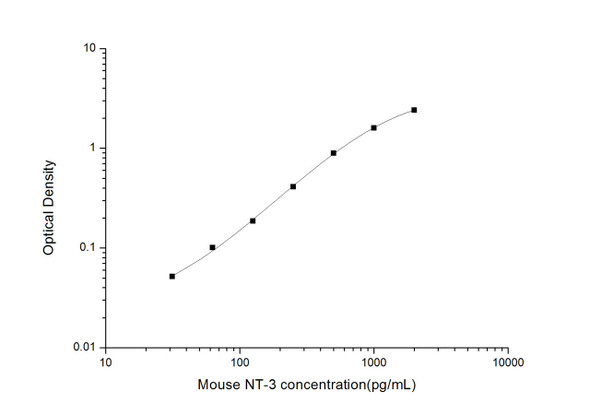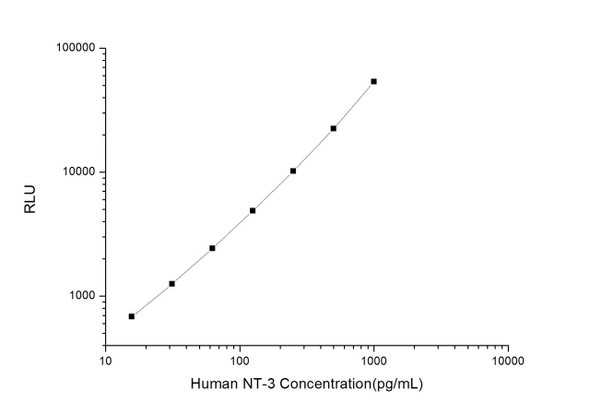Human NT-3 (Neurotrophin-3) ELISA Kit (HUES02844)
- SKU:
- HUES02844
- Product Type:
- ELISA Kit
- Size:
- 96 Assays
- Uniprot:
- P20783
- Sensitivity:
- 46.88pg/mL
- Range:
- 78.13-5000pg/mL
- ELISA Type:
- Sandwich
- Synonyms:
- NT3, NTF3, HDNF, NGF-2, NGF2
- Reactivity:
- Human
- Sample Type:
- Serum, plasma and other biological fluids
- Research Area:
- Cell Biology
Description
Human NT-3 (Neurotrophin-3) ELISA Kit
The Human NT-3 (Neurotrophin-3) ELISA Kit is a cutting-edge tool for the precise measurement of neurotrophin-3 levels in human biological samples such as serum, plasma, and cell culture supernatants. With its outstanding sensitivity and specificity, this kit delivers accurate and consistent results, making it a valuable asset for a wide array of research endeavors.Neurotrophin-3, a key player in the neurotrophin family, plays a crucial role in nerve growth and survival.
It is implicated in various neurological disorders and conditions, including neurodevelopmental disorders, neurodegenerative diseases, and psychiatric disorders. By enabling the precise quantification of NT-3 levels, this ELISA kit facilitates in-depth research into these conditions and offers insight into potential therapeutic interventions.
| Assay type: | Sandwich |
| Format: | 96T |
| Assay time: | 4.5h |
| Reactivity: | Human |
| Detection Method: | Colormetric |
| Detection Range: | 78.13-5000 pg/mL |
| Sensitivity: | 46.88 pg/mL |
| Sample Volume Required Per Well: | 100µL |
| Sample Type: | Serum, plasma and other biological fluids |
| Specificity: | This kit recognizes Human NT-3 in samples. No significant cross-reactivity or interference between Human NT-3 and analogues was observed. |
This ELISA kit uses Sandwich-ELISA as the method. The micro ELISA plate provided in this kit has been pre-coated with an antibody specific to Human NT-3. Standards or samples are added to the appropriate micro ELISA plate wells and combined with the specific antibody. Then a biotinylated detection antibody specific for Human NT-3 and Avidin-Horseradish Peroxidase (HRP) conjugate are added to each micro plate well successively and incubated. Free components are washed away. The substrate solution is added to each well. Only those wells that contain Human NT-3, biotinylated detection antibody and Avidin-HRP conjugate will appear blue in color. The enzyme-substrate reaction is terminated by adding Stop Solution and the color turns yellow. The optical density (OD) is measured spectrophotometrically at a wavelength of 450 nm ± 2 nm. The OD value is proportional to the concentration of Human NT-3. The concentration of Human NT-3 in samples can be calculated by comparing the OD of the samples to the standard curve.
| UniProt Protein Function: | NT-3: Seems to promote the survival of visceral and proprioceptive sensory neurons. Belongs to the NGF-beta family. 2 isoforms of the human protein are produced by alternative splicing. |
| UniProt Protein Details: | Protein type:Cytokine; Secreted, signal peptide; Secreted Chromosomal Location of Human Ortholog: 12p13 Cellular Component: cytoplasmic membrane-bound vesicle; extracellular region Molecular Function:neurotrophin p75 receptor binding; growth factor activity; nerve growth factor binding; receptor binding; chemoattractant activity Biological Process: myelination; axon guidance; mechanoreceptor differentiation; epidermis development; glial cell fate determination; activation of MAPK activity; regulation of neuron differentiation; positive regulation of receptor internalization; positive regulation of glial cell differentiation; signal transduction; enteric nervous system development; induction of positive chemotaxis; positive chemotaxis; cell-cell signaling; positive regulation of cell proliferation; negative regulation of neuron apoptosis; regulation of synaptic transmission; negative regulation of peptidyl-tyrosine phosphorylation; nervous system development; activation of protein kinase B; positive regulation of peptidyl-serine phosphorylation; peripheral nervous system development; positive regulation of peptidyl-tyrosine phosphorylation; neuromuscular synaptic transmission; nerve development; smooth muscle cell differentiation; positive regulation of transcription from RNA polymerase II promoter; brain development; transmembrane receptor protein tyrosine kinase signaling pathway; neurite morphogenesis; positive regulation of cell migration |
| NCBI Summary: | The protein encoded by this gene is a member of the neurotrophin family, that controls survival and differentiation of mammalian neurons. This protein is closely related to both nerve growth factor and brain-derived neurotrophic factor. It may be involved in the maintenance of the adult nervous system, and may affect development of neurons in the embryo when it is expressed in human placenta. NTF3-deficient mice generated by gene targeting display severe movement defects of the limbs. The mature peptide of this protein is identical in all mammals examined including human, pig, rat and mouse. [provided by RefSeq, Jul 2008] |
| UniProt Code: | P20783 |
| NCBI GenInfo Identifier: | 128581 |
| NCBI Gene ID: | 4908 |
| NCBI Accession: | P20783. 1 |
| UniProt Secondary Accession: | P20783,Q6FH50, B7Z1T5, |
| UniProt Related Accession: | P20783 |
| Molecular Weight: | 30,800 Da |
| NCBI Full Name: | Neurotrophin-3 |
| NCBI Synonym Full Names: | neurotrophin 3 |
| NCBI Official Symbol: | NTF3 |
| NCBI Official Synonym Symbols: | NT3; HDNF; NGF2; NT-3; NGF-2 |
| NCBI Protein Information: | neurotrophin-3; neurotrophic factor; nerve growth factor 2 |
| UniProt Protein Name: | Neurotrophin-3 |
| UniProt Synonym Protein Names: | HDNF; Nerve growth factor 2; NGF-2; Neurotrophic factor |
| Protein Family: | Neurotrophin |
| UniProt Gene Name: | NTF3 |
| UniProt Entry Name: | NTF3_HUMAN |
As the OD values of the standard curve may vary according to the conditions of the actual assay performance (e. g. operator, pipetting technique, washing technique or temperature effects), the operator should establish a standard curve for each test. Typical standard curve and data is provided below for reference only.
| Concentration (pg/mL) | O.D | Average | Corrected |
| 5000 | 2.456 2.466 | 2.461 | 2.389 |
| 2500 | 1.737 1.751 | 1.744 | 1.672 |
| 1250 | 0.961 0.955 | 0.958 | 0.886 |
| 625 | 0.488 0.518 | 0.503 | 0.431 |
| 312.5 | 0.264 0.248 | 0.256 | 0.184 |
| 156.25 | 0.181 0.179 | 0.18 | 0.108 |
| 78.13 | 0.123 0.131 | 0.127 | 0.055 |
| 0 | 0.066 0.078 | 0.072 | -- |
Precision
Intra-assay Precision (Precision within an assay): 3 samples with low, mid range and high level Human NT-3 were tested 20 times on one plate, respectively.
Inter-assay Precision (Precision between assays): 3 samples with low, mid range and high level Human NT-3 were tested on 3 different plates, 20 replicates in each plate.
| Intra-assay Precision | Inter-assay Precision | |||||
| Sample | 1 | 2 | 3 | 1 | 2 | 3 |
| n | 20 | 20 | 20 | 20 | 20 | 20 |
| Mean (pg/mL) | 243.98 | 710.49 | 2423.41 | 232.23 | 705.96 | 2320.63 |
| Standard deviation | 16.88 | 35.74 | 104.69 | 13.61 | 31.56 | 73.10 |
| C V (%) | 6.92 | 5.03 | 4.32 | 5.86 | 4.47 | 3.15 |
Recovery
The recovery of Human NT-3 spiked at three different levels in samples throughout the range of the assay was evaluated in various matrices.
| Sample Type | Range (%) | Average Recovery (%) |
| Serum (n=5) | 86-98 | 92 |
| EDTA plasma (n=5) | 89-100 | 95 |
| Cell culture media (n=5) | 88-100 | 93 |
Linearity
Samples were spiked with high concentrations of Human NT-3 and diluted with Reference Standard & Sample Diluent to produce samples with values within the range of the assay.
| Serum (n=5) | EDTA plasma (n=5) | Cell culture media (n=5) | ||
| 1:2 | Range (%) | 91-103 | 93-108 | 89-100 |
| Average (%) | 97 | 100 | 95 | |
| 1:4 | Range (%) | 92-107 | 81-92 | 88-99 |
| Average (%) | 97 | 87 | 93 | |
| 1:8 | Range (%) | 91-105 | 80-92 | 87-101 |
| Average (%) | 99 | 85 | 94 | |
| 1:16 | Range (%) | 87-102 | 88-101 | 87-97 |
| Average (%) | 94 | 93 | 92 |
An unopened kit can be stored at 4°C for 1 month. If the kit is not used within 1 month, store the items separately according to the following conditions once the kit is received.
| Item | Specifications | Storage |
| Micro ELISA Plate(Dismountable) | 8 wells ×12 strips | -20°C, 6 months |
| Reference Standard | 2 vials | |
| Concentrated Biotinylated Detection Ab (100×) | 1 vial, 120 µL | |
| Concentrated HRP Conjugate (100×) | 1 vial, 120 µL | -20°C(shading light), 6 months |
| Reference Standard & Sample Diluent | 1 vial, 20 mL | 4°C, 6 months |
| Biotinylated Detection Ab Diluent | 1 vial, 14 mL | |
| HRP Conjugate Diluent | 1 vial, 14 mL | |
| Concentrated Wash Buffer (25×) | 1 vial, 30 mL | |
| Substrate Reagent | 1 vial, 10 mL | 4°C(shading light) |
| Stop Solution | 1 vial, 10 mL | 4°C |
| Plate Sealer | 5 pieces | |
| Product Description | 1 copy | |
| Certificate of Analysis | 1 copy |
- Set standard, test sample and control (zero) wells on the pre-coated plate and record theirpositions. It is recommended to measure each standard and sample in duplicate. Note: addall solutions to the bottom of the plate wells while avoiding contact with the well walls. Ensuresolutions do not foam when adding to the wells.
- Aliquot 100µl of standard solutions into the standard wells.
- Add 100µl of Sample / Standard dilution buffer into the control (zero) well.
- Add 100µl of properly diluted sample (serum, plasma, tissue homogenates and otherbiological fluids) into test sample wells.
- Cover the plate with the sealer provided in the kit and incubate for 90 min at 37°C.
- Aspirate the liquid from each well, do not wash. Immediately add 100µL of BiotinylatedDetection Ab working solution to each well. Cover the plate with a plate seal and gently mix. Incubate for 1 hour at 37°C.
- Aspirate or decant the solution from the plate and add 350µL of wash buffer to each welland incubate for 1-2 minutes at room temperature. Aspirate the solution from each well andclap the plate on absorbent filter paper to dry. Repeat this process 3 times. Note: a microplatewasher can be used in this step and other wash steps.
- Add 100µL of HRP Conjugate working solution to each well. Cover with a plate seal andincubate for 30 min at 37°C.
- Aspirate or decant the solution from each well. Repeat the wash process for five times asconducted in step 7.
- Add 90µL of Substrate Reagent to each well. Cover with a new plate seal and incubate forapproximately 15 min at 37°C. Protect the plate from light. Note: the reaction time can beshortened or extended according to the actual color change, but not by more than 30min.
- Add 50 µL of Stop Solution to each well. Note: Adding the stop solution should be done inthe same order as the substrate solution.
- Determine the optical density (OD value) of each well immediately with a microplate readerset at 450 nm.







